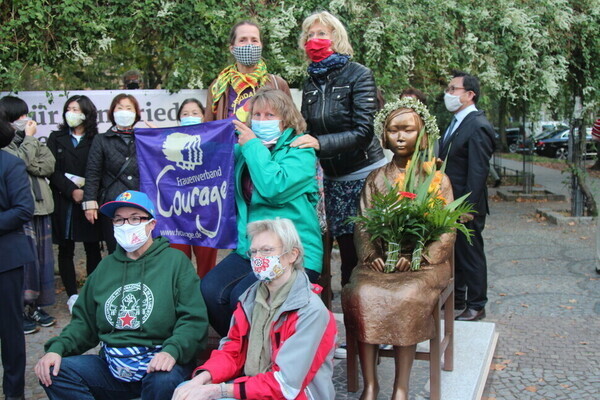hankyoreh
Links to other country sites 다른 나라 사이트 링크
Japanese PM asked German chancellor to take down “comfort women” statue in Berlin

Japanese Prime Minister Fumio Kishida personally asked German Chancellor Olaf Scholz for help to remove the Statue of Peace in Berlin dedicated to victims of the “comfort women” system of sexual slavery, reports indicate.
Japanese daily Sankei Shimbun reported on Wednesday that on April 28, Kishida asked Scholz for the removal of the Statue of Peace installed in Berlin’s Mitte borough, saying, “The continued existence of the installment is regrettable. It completely diverges from Japan’s stance.”
The Japanese government has reportedly requested that the German government help take down the statue through various channels before, but never before has a Japanese prime minister made such a request during a summit.
Sankei Shimbun reported that Scholz’s reaction was not favorable, noting that while he stated that he considered relations with Japan important, the statue fell under the jurisdiction of the specific borough, which meant that the German government’s hands were tied on the matter.
Quoting an anonymous source within the Japanese government, the newspaper reported that while pressure to remove the statue had been applied on multiple channels, having the prime minister make the request was meant to send a strong message.
The Statue of Peace was erected in Berlin’s Mitte borough on Sept. 28, 2020, through the combined advocacy of the German-Korean civic group known as Korea Verband, members of the Japanese Women’s Initiative in Berlin, and German organizations for cultural movements. Immediately following the installment, Japan began its campaign pressuring for the statue’s removal, with then-Japanese Foreign Minister Toshimitsu Motegi making a request to the then-German foreign minister during a video conference that the statue be removed. As a result, the Mitte administrative office ordered the statue’s removal on Oct. 7, only two weeks after it was installed.
However, Korea Verband launched a legal battle to preserve the statue by applying for an injunction against the removal order at a German administrative court. Members of German civil society criticized the Mitte authorities as well, which led the district to decide to retain the statue.
Since then, the administrative office in Mitte extended the statue’s installation period by one year last September until Sept. 28 of this year according to the recommendation made by its committee that deals with art in urban spaces. However, with the Japanese prime minister actively demanding the statue’s removal, it’s becoming harder to be optimistic about the statue’s prospects after its installation period expires.
By Cho Ki-weon, staff reporter
Please direct questions or comments to [english@hani.co.kr]

Editorial・opinion
![[Column] Park Geun-hye déjà vu in Yoon Suk-yeol [Column] Park Geun-hye déjà vu in Yoon Suk-yeol](https://flexible.img.hani.co.kr/flexible/normal/500/300/imgdb/original/2024/0424/651713945113788.jpg) [Column] Park Geun-hye déjà vu in Yoon Suk-yeol
[Column] Park Geun-hye déjà vu in Yoon Suk-yeol![[Editorial] New weight of N. Korea’s nuclear threats makes dialogue all the more urgent [Editorial] New weight of N. Korea’s nuclear threats makes dialogue all the more urgent](https://flexible.img.hani.co.kr/flexible/normal/500/300/imgdb/original/2024/0424/7317139454662664.jpg) [Editorial] New weight of N. Korea’s nuclear threats makes dialogue all the more urgent
[Editorial] New weight of N. Korea’s nuclear threats makes dialogue all the more urgent- [Guest essay] The real reason Korea’s new right wants to dub Rhee a founding father
- [Column] ‘Choson’: Is it time we start referring to N. Korea in its own terms?
- [Editorial] Japan’s rewriting of history with Korea has gone too far
- [Column] The president’s questionable capacity for dialogue
- [Column] Are chaebol firms just pizza pies for families to divvy up as they please?
- [Column] Has Korea, too, crossed the Rubicon on China?
- [Correspondent’s column] In Japan’s alliance with US, echoes of its past alliances with UK
- [Editorial] Does Yoon think the Korean public is wrong?
Most viewed articles
- 1[Column] Park Geun-hye déjà vu in Yoon Suk-yeol
- 2Will NewJeans end up collateral damage in internal feud at K-pop juggernaut Hybe?
- 3N. Korean hackers breached 10 defense contractors in South for months, police say
- 4[Guest essay] The real reason Korea’s new right wants to dub Rhee a founding father
- 5Up-and-coming Indonesian group StarBe spills what it learned during K-pop training in Seoul
- 6[Editorial] Japan’s rewriting of history with Korea has gone too far
- 7Why Korea shouldn’t welcome Japan’s newly beefed up defense cooperation with US
- 8Terry Anderson, AP reporter who informed world of massacre in Gwangju, dies at 76
- 9Thursday to mark start of resignations by senior doctors amid standoff with government
- 10Senior doctors cut hours, prepare to resign as government refuses to scrap medical reform plan